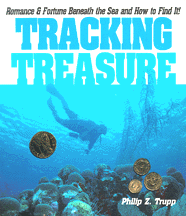 |
Tracking TreasureBy Phil TruppEXCERPT FROM TRACKING TREASURE |
Time Capsules in the Sea
From a scientific and historical perspective the finding of a shipwreck is like no other
discovery. Sunken vessels represent a moment in time, a frozen instant of calamity. Each
reflects almost completely the society from which it came-a microcosm of life sealed
away until we come upon it. With good reason, shipwrecks are sometimes referred to as
"time capsules." On land, antiquities are subjected to the ravages of wind, rain, and
erosion, and the most serious threat of all, the looter. But ships undisturbed on the
bottom of the sea are locked away in an airless environment, preserved like a portrait
behind hermetically sealed glass.
Only a few years ago our best scientists believed that the sea was a kind of gigantic
disposal. We were taught that the seabed was a lifeless, featureless void, and that
everything down there was destroyed by the corrosive properties of seawater. By
accident we discovered that just the opposite is true. In 1968, the research submarine
Alvin was under tow when a cable parted and the vessel sank in 5,500 feet of water off
Cape Cod. Lunch boxes were lashed to the sub. Some months later Alvin was recovered,
lunch boxes still in place. When the scientists inspected the contents, which included
meats, bread, vegetables, and sweets, they were pretty soggy-but edible. They had been
marvelously preserved in the cold, airless cradle of the deep. The message of Alvin was
that the deep ocean is a great conservator.
To understand what happens when a ship goes down, imagine being adrift when the
vessel begins to break up and sink. You look over the wave tops and see that she is
damaged and listing; wind and waves deliver terrible blows, accounting for a greater
portion of the damage. Then comes the long slide to the bottom. On the way down the air
spaces are crushed by water pressure. Falling through a medium eight times denser than
air, loose objects float away, and the ship begins to lose some of its identity as it
continues to break up. If your ear is beneath the surface you can actually hear the sound
of the ship dying, a sound you're likely never to forget. It is a mournful wail, like the
voice of a lone whale in the deep ocean. World War II submariners claimed they heard
their victims sinking through the hull of their submarine; they say a steel hull crushed by
water pressure "screams" like dissonant violins; a wooden ship is softer, but no less
forbidding. The fidelity of the sound is remarkable and it comes from all directions
simultaneously, since water conducts sound five times more efficiently and clearly than
air.
Ships impact the bottom moving at 30 to 60 miles per hour. The superstructure (deck
cabins, masts, rigging, and all decks above the hull) tears away from the ship's hull and
will eventually topple over into the sand. The entire catastrophe sounds like a muffled
kettle drum. Any cannons on deck will settle into the sand, or fall backward into the hull.
The site will be marked by scattered patterns of cannons, anchors, and other heavy
objects.
The ship will begin to stabilize in its new environment. A few more objects will fall off the
existing structures and form strange shapes on the sand. Heavy cargo will work through
the hull as gravity pulls it into the bottom. Years pass. A century later, a wooden ship has
become only a suggestion of her former self. She sinks deep in the sand. In tropical
areas, living corals will grow over every inch of exposed metal. If she lies in shallow
water, say 30 feet or less, currents, surge, hurricanes, and man will work on her with
their combined fury. In time, the ship may be scattered over miles of bottom, but the
mother lode - the bulk of her cargo - generally remains in place, sinking ever deeper, like
a glowing diamond returning to its sources deep in the earth.
Yet despite the hostile environment of the sea, where teredo worms can make a meal of a
wooden ship in just a few years, the ship holds her own. Deep water seems to protect a
sunken vessel, keeping her structure intact. Cold water, too, is a great preserver.
Though scientists now say the victims of the Titanic were long ago consumed by sea
creatures, I believe it is more likely that they are in a state of preservation that may rival
Egyptian mummies. Those with a grisly curiosity can witness this for themselves in the
cold waters of the Great Lakes, where the victims of the merchant ship Kamloops
remain entombed nearly a century after sinking, their soft tissues still intact.